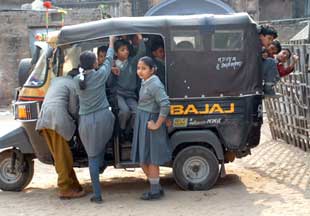Staying Safe on the Road Road Safety Around the World
Asia Gets Motorized
Motor vehicles have been in use the longest in the United States and Europe. Thus safety standards were first developed in these places. For example, in the United States the rate of seat-belt use had increased to 83% by 2008. Vehicles made in the United States once dominated the auto market, but car manufacturers in Japan overtook them long ago. However, South Korea and more recently China and India have begun taking a larger chunk of vehicles sales.
The newer auto manufacturers make much less expensive vehicles, in countries where the economy has grown rapidly. Many people can now afford their own automobiles, where they once could not. The safety standards and equipment developed in the United States, Europe, and Japan are being applied to vehicles around the world. Despite that, accident rates have skyrocketed, particularly in Asia. More than half of the world’s traffic fatalities occur in the Asia Pacific region despite the fact that only one in five of the world’s motor vehicles is registered there. Currently, more than half the traffic fatalities in the Asia Pacific region occur in China and India. By 2020 the United Nations estimates that about two-thirds of the world’s road deaths will occur in that region. The steepest increases are predicted to be in China, Southeast Asia, and India, where road-death rates will likely rise by 92%, 144%, and 147%, respectively.
Road safety depends on a combination of factors: the technical safety of vehicles themselves; the behavior of drivers, riders, and pedestrians; and the quality of roads. All these aspects arouse concern in more recently motorized Asian countries, places with lots of new drivers. For example, driving standards are low in India and China, resulting in much careless driving and speeding. The use of seat belts and motorcycle helmets is required in most Asian countries, but many people do not use this equipment because enforcement of the law varies widely. Child restraints are not yet widely mandated. Driving under the influence of drugs or alcohol is also a major problem in some countries, and enforcement of the laws against it may be weak.
|
Schoolchildren in Jaipur, India, are crowding into a taxi that will take them to school. In many places, unsafe methods of traveling are commonly used. |
To compound the problem, cars in many Asian countries share the roads not only with trucks and buses but with a multitude of two- and three-wheeled vehicles (motorized and not), pedestrians, and animal-pulled carts. In fact, the largest number of those killed or injured in road accidents in Asia are pedestrians and motorcyclists. In South Asia, more than 50% of road fatalities are in pedestrians. In Southeast Asia, more than two-thirds are motorcyclists.
The safety standards of cars manufactured in India and China vary enormously. Both countries host numerous foreign car plants, producing cars for the international market, which must necessarily meet international standards. The same is true for cars imported from elsewhere. Domestic standards, however, are not the same. India, for example, has adopted only 74 of the 124 UNECE standards. In 2008 the Indian automaker Tata Motors announced the production of a new car, the Nano, which will cost only $2,500. This makes it the world’s least expensive car. However, the Nano lacks protections such as air bags and antilock brakes. China hopes to export cars to the West, but models produced by its Chery Automobile Company and Brilliance Auto failed Western crash tests in 2007. Since then, China has reached an agreement with the U.S. NHTSA to create and enforce more-effective safety standards. Older cars present another problem. There are many, many old cars—or cars built to very old standards—on the road in India, especially.
The governments of Asian countries recognize road safety as a major problem for their societies. Almost all of them have begun safety programs, some with such ambitious goals as having "the safest roads in the world" (Japan) and achieving "a year without accidents" (Mongolia). Others are rather more specific. In Malaysia, where half the motorized vehicles are motorcycles, the government began to require the bikes to have daylight running headlights in 1992. This program reduced visibility-related accidents by an estimated 30%. Several other countries followed suit.
Governments are beginning to mandate the use of child restraints and motorcycle helmets, in addition to seat belts. They are also trying to step up enforcement of these rules as well as speed limits and laws about driving under the influence. Driver-safety and other road-safety education programs have been implemented. And major efforts have been made to improve the condition of the roads.
 |
 |
|
|
Photos courtesy of Kermitz Fraga Roads in remote regions such as the Amazon may not be as modernized as urban roads. These roads require very skilled drivers to travel safely on them. |
||
Many countries are starting to conduct safety audits of their roads. These include identifying areas in which crashes are frequent, known as black spots. China, for one, has launched a large-scale program to correct the unsafe conditions at these spots. In addition, new, higher standards are being introduced in road engineering and construction. In Southeast Asia, where motorcycles are very prevalent, proposals have been made to create separate lanes for these vulnerable vehicles. It is hoped that all these measures will bear fruit. In India, where in 2006 more than 100,000 people died and an estimated 2 million were seriously injured in road accidents, one politician said, "You're fighting a war, and you need a structured army to fight that war."
More Vehicles, More Fatalities
Africa also faces road-safety problems, with 11% of the world’s road fatalities. This is three times as large as its share of the world’s motor vehicles. Overall, sub-Saharan Africa has the second-highest per-capita road-death rate of any region in the world, 24 per 100,000. Road fatalities are rising in most African countries. By 2020 the regional rate is expected to have increased by 80%. The exception is South Africa, where road-fatality numbers are stable. The country has a relatively large number of motor vehicles, and drivers account for a much larger share of deaths than elsewhere. Pedestrians represent the largest number of road deaths in all countries except Botswana and Malawi, where passenger deaths are more numerous. In Kenya and Tanzania, bicyclists represent 9% and 11%, respectively, of road fatalities.
The Middle East and North Africa have 2% of the world’s motor vehicles and experience 6% of the world’s road fatalities. A 68% increase in fatalities is expected by 2020.
Latin America and the Caribbean region currently have the highest per-capita death rate from road accidents, 26.1 deaths per 100,000 population. That figure is expected to rise to 31 per 100,000 by 2020.
Governments around the world realize that reducing the accident and death rates will take great effort.
This content has been re-published with permission from SEED. Copyright © 2025 Schlumberger Excellence in Education Development (SEED), Inc.


